Irreversible AE1 tyrosine phosphorylation leads to membrane vesiculation in G6PD deficient red cells
- PMID: 21246053
- PMCID: PMC3016414
- DOI: 10.1371/journal.pone.0015847
Irreversible AE1 tyrosine phosphorylation leads to membrane vesiculation in G6PD deficient red cells
Abstract
Background: While G6PD deficiency is one of the major causes of acute hemolytic anemia, the membrane changes leading to red cell lysis have not been extensively studied. New findings concerning the mechanisms of G6PD deficient red cell destruction may facilitate our understanding of the large individual variations in susceptibility to pro-oxidant compounds and aid the prediction of the hemolytic activity of new drugs.
Methodology/principal findings: Our results show that treatment of G6PD deficient red cells with diamide (0.25 mM) or divicine (0.5 mM) causes: (1) an increase in the oxidation and tyrosine phosphorylation of AE1; (2) progressive recruitment of phosphorylated AE1 in large membrane complexes which also contain hemichromes; (3) parallel red cell lysis and a massive release of vesicles containing hemichromes. We have observed that inhibition of AE1 phosphorylation by Syk kinase inhibitors prevented its clustering and the membrane vesiculation while increases in AE1 phosphorylation by tyrosine phosphatase inhibitors increased both red cell lysis and vesiculation rates. In control RBCs we observed only transient AE1 phosphorylation.
Conclusions/significance: Collectively, our findings indicate that persistent tyrosine phosphorylation produces extensive membrane destabilization leading to the loss of vesicles which contain hemichromes. The proposed mechanism of hemolysis may be applied to other hemolytic diseases characterized by the accumulation of hemoglobin denaturation products.
Conflict of interest statement
Figures





Similar articles
-
Oxidized and poorly glycosylated band 3 is selectively phosphorylated by Syk kinase to form large membrane clusters in normal and G6PD-deficient red blood cells.Biochem J. 2009 Mar 1;418(2):359-67. doi: 10.1042/BJ20081557. Biochem J. 2009. PMID: 18945214
-
[Changes of protein tyrosine phosphorylation in erythrocyte band 3 glucose-6-phosphate dehydrogenase deficiency].Zhonghua Xue Ye Xue Za Zhi. 2002 Nov;23(11):565-7. Zhonghua Xue Ye Xue Za Zhi. 2002. PMID: 12482337 Chinese.
-
A comprehensive analysis of membrane and morphology of erythrocytes from patients with glucose-6-phosphate dehydrogenase deficiency.J Struct Biol. 2016 Jun;194(3):235-43. doi: 10.1016/j.jsb.2015.10.015. Epub 2015 Oct 20. J Struct Biol. 2016. PMID: 26496826
-
Cell membrane surface expression and tyrosine kinase regulate the osmolyte channel (skAE1) in skate erythrocytes.Acta Physiol (Oxf). 2006 May-Jun;187(1-2):87-91. doi: 10.1111/j.1748-1716.2006.01556.x. Acta Physiol (Oxf). 2006. PMID: 16734745 Review.
-
Defective kidney anion-exchanger 1 (AE1, Band 3) trafficking in dominant distal renal tubular acidosis (dRTA).Biochem Soc Symp. 2005;(72):47-63. doi: 10.1042/bss0720047. Biochem Soc Symp. 2005. PMID: 15649129 Review.
Cited by
-
Survival of red blood cells after transfusion: processes and consequences.Front Physiol. 2013 Dec 18;4:376. doi: 10.3389/fphys.2013.00376. Front Physiol. 2013. PMID: 24391593 Free PMC article. Review.
-
Circulating membrane-derived microvesicles in redox biology.Free Radic Biol Med. 2014 Aug;73:214-28. doi: 10.1016/j.freeradbiomed.2014.04.017. Epub 2014 Apr 18. Free Radic Biol Med. 2014. PMID: 24751526 Free PMC article. Review.
-
Global transformation of erythrocyte properties via engagement of an SH2-like sequence in band 3.Proc Natl Acad Sci U S A. 2016 Nov 29;113(48):13732-13737. doi: 10.1073/pnas.1611904113. Epub 2016 Nov 15. Proc Natl Acad Sci U S A. 2016. PMID: 27856737 Free PMC article.
-
Erythrocyte mitogen-activated protein kinases mediate hemolytic events under osmotic and oxidative stress and in hemolytic diseases.Cell Signal. 2022 Nov;99:110450. doi: 10.1016/j.cellsig.2022.110450. Epub 2022 Aug 25. Cell Signal. 2022. PMID: 36029940 Free PMC article.
-
Testosterone-dependent sex differences in red blood cell hemolysis in storage, stress, and disease.Transfusion. 2016 Oct;56(10):2571-2583. doi: 10.1111/trf.13745. Epub 2016 Aug 9. Transfusion. 2016. PMID: 27507802 Free PMC article.
References
-
- Beutler E, Duparc S. Glucose-6-phosphate dehydrogenase deficiency and antimalarial drug development. The American journal of tropical medicine and hygiene. 2007;77:779–789. - PubMed
-
- Cappellini MD, Fiorelli G. Glucose-6-phosphate dehydrogenase deficiency. Lancet. 2008;371:64–74. - PubMed
-
- Luzzatto L. Glucose 6-phosphate dehydrogenase deficiency: from genotype to phenotype. Haematologica. 2006;91:1303–1306. - PubMed
-
- Baker MA, Bosia A, Pescarmona G, Turrini F, Arese P. Mechanism of action of divicine in a cell-free system and in glucose-6-phosphate dehydrogenase-deficient red cells. Toxicologic pathology. 1984;12:331–336. - PubMed
Publication types
MeSH terms
Substances
LinkOut - more resources
Full Text Sources
Medical
Miscellaneous

